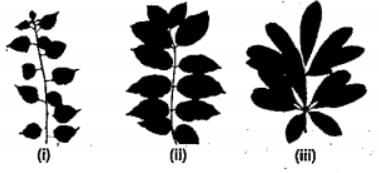Test: The Leaf (NCERT) - NEET MCQ
10 Questions MCQ Test NCERTs at Fingertips: Textbooks, Tests & Solutions - Test: The Leaf (NCERT)
Which of the following statements is/are false about the leaf?
a. The leaf develops at the node and bears a bud in its axil.
b. The leaf is the most important vegetative organ for photosynthesis.
c. Pulvinus provides rigidity to the leaf blade and acts as a channel for transporting water, minerals and food materials.
a. The leaf develops at the node and bears a bud in its axil.
b. The leaf is the most important vegetative organ for photosynthesis.
c. Pulvinus provides rigidity to the leaf blade and acts as a channel for transporting water, minerals and food materials.
In some _____, the leaf base may become swoolen and is called as _____.
In _____ phyllotaxy, a pair of leaves arise at each node and lie opposite to each other as in _____ plant.
Which among the following is incorrect about reticulate and parallel venation?
Study the given figures and identify the kind of phyllotaxy.

When leaflets one joined together at a common point at the petiole the leaf is called?
What is the key difference between pinnately compound leaves and palmately compound leaves?
|
237 docs|243 tests
|





















